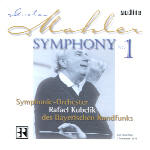Rafael Kubelik enjoyed making recordings, particularly of Mahler symphonies, which he felt benefited from the perfection achievable under studio conditions. This accounts at least in part for the sometimes striking differences between his live and studio performances of the same work. It would be too simplistic to say that the whole matter boils down to “cool and controlled” versus “passionate and free” interpretations. At all times, Kubelik remained a vital, intense, committed conductor of whatever music he was playing. However, he was one of the few artists self-aware enough to recognize the fact that the kind of spontaneity that he permitted himself in front of an audience might not always transfer well to disc. This is certainly one of the reasons his discographic legacy has worn so well over time. And although his live recordings are few and far between from his early years, they do increase in frequency as his interpretations matured and his relationship with his own Bavarian Radio Symphony Orchestra grew to the point where he had no doubts about the quality of the results he could obtain in concert.
Kubelik’s complete Mahler cycle for DG remains one of the most satisfying available (and miracle of miracles, it has actually remained available!) precisely because of its impressive musicality, balance, excitement, and inner tension. The First Symphony, in particular, has served as a reference edition of the work since the day it was recorded (in 1968). This live performance, taken from a concert on November 2, 1979, adds to the vernal freshness and warmth of Kubelik’s studio version a glorious, almost transcendental flexibility of pulse, the sort of thing that only happens when orchestra and conductor are completely in sync with each other. Even better, the technical quality of the playing has noticeably improved; the big moments (the climaxes of the first movement and finale) explode with the sort of energy that you usually associate with Leonard Bernstein, though without the slightest trace of exaggeration or expressive underlying that some listeners (but not me) object to in Lenny’s Mahler. Kubelik always had a special way with the Jewish tunes in the third movement funeral march, largely a function of his treatment of the trumpets, and he indulges the music’s nostalgic vulgarity even more fearlessly than previously. The first movement flows effortlessly from its magical opening right through to its rambunctious final bars, while the scherzo’s rustic high spirits and peasant dance rhythms spring directly from Kubelik’s Bohemian roots.
In short, this performance, like the Mahler Fifth Symphony similarly available from Audite as well as the Seventh in the New York Philharmonic’s Mahler box, occupies a special place in the pantheon of great Mahler symphony recordings. Audite’s sonics allow the full glory of Kubelik’s vision to emerge with complete naturalness. If you love Mahler, you must hear this no matter how many other Firsts you may have in your collection.
































